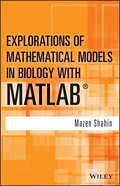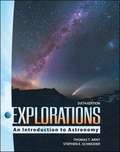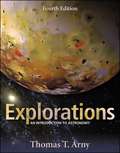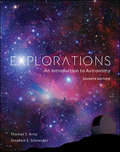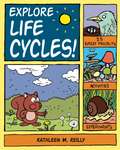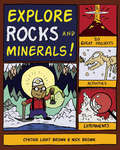- Table View
- List View
Explorations in Earth Science:The Physical Setting
by Richard Osmun Brian Vorwald Sally WegnerExplorations in Earth Science contains a collection of 68 laboratory investigations that can be incorporated into an Earth science course that covers geology, weather, climate, astronomy, and environmental issues. The variety of the exercises contained in the manual provides instructors with the flexibility to use those that suit their individual preferences and which they view as essential for their students. Included is a Prologue that contains activities that address the skills and concepts that are integrated throughout an Earth science course. The investigations are aligned with the New York State Math, Science, and Technology Standards and the National Science Education Standards. Appendices in the manual correlate labs to the New York State Physical Setting/Earth Science Core Curriculum and several well-known textbooks. Also included are appendices containing the Earth Science Reference Tables required by the New York State Physical Setting Core Curriculum and supplementary charts teachers will find useful in delivering their courses. Incorporated into the Teacher's Edition is an appendix suggesting Internet sites appropriate for each chapter. Each laboratory investigation contains clearly stated instructions, report sheets, and questions that reflect both the procedural techniques and results students should obtain. Many labs can be adapted to an inquiry/problem-solving approach in which the written activity would often serve the teacher as a guide, but might not be used by students. The Teacher's Edition contains an array of suggested long-term investigations, an equipment and supplies list, and a comprehensive guide preceding each activity. This section is of great use to veteran teachers and is most valuable to teachers new to teaching Earth Science.
Explorations in Neuroscience, Psychology and Religion (Routledge Science and Religion Series)
by Kevin S. SeyboldIn the 1990s great strides were taken in clarifying how the brain is involved in behaviors that, in the past, had seldom been studied by neuroscientists or psychologists. This book explores the progress begun during that momentous decade in understanding why we behave, think and feel the way we do, especially in those areas that interface with religion. What is happening in the brain when we have a religious experience? Is the soul a product of the mind which is, in turn, a product of the brain? If so, what are the implications for the Christian belief in an afterlife? If God created humans for the purpose of having a relationship with him, should we expect to find that our spirituality is a biologically evolved human trait? What effect might a disease such as Alzheimer's have on a person's spirituality and relationship with God? Neuroscience and psychology are providing information relevant to each of these questions, and many Christians are worried that their religious beliefs are being threatened by this research. Kevin Seybold attempts to put their concerns to rest by presenting some of the scientific findings coming from these disciplines in a way that is understandable yet non-threatening to Christian belief.
Explorations in Quantum Computing
by Colin P. WilliamsBy the year 2020, the basic memory components of a computer will be the size of individual atoms. At such scales, the current theory of computation will become invalid. "Quantum computing" is reinventing the foundations of computer science and information theory in a way that is consistent with quantum physics - the most accurate model of reality currently known. Remarkably, this theory predicts that quantum computers can perform certain tasks breathtakingly faster than classical computers - and, better yet, can accomplish mind-boggling feats such as teleporting information, breaking supposedly "unbreakable" codes, generating true random numbers, and communicating with messages that betray the presence of eavesdropping. This widely anticipated second edition of Explorations in Quantum Computing explains these burgeoning developments in simple terms, and describes the key technological hurdles that must be overcome to make quantum computers a reality. This easy-to-read, time-tested, and comprehensive textbook provides a fresh perspective on the capabilities of quantum computers, and supplies readers with the tools necessary to make their own foray into this exciting field. Topics and features: concludes each chapter with exercises and a summary of the material covered; provides an introduction to the basic mathematical formalism of quantum computing, and the quantum effects that can be harnessed for non-classical computation; discusses the concepts of quantum gates, entangling power, quantum circuits, quantum Fourier, wavelet, and cosine transforms, and quantum universality, computability, and complexity; examines the potential applications of quantum computers in areas such as search, code-breaking, solving NP-Complete problems, quantum simulation, quantum chemistry, and mathematics; investigates the uses of quantum information, including quantum teleportation, superdense coding, quantum data compression, quantum cloning, quantum negation, and quantum cryptography; reviews the advancements made towards practical quantum computers, covering developments in quantum error correction and avoidance, and alternative models of quantum computation. This text/reference is ideal for anyone wishing to learn more about this incredible, perhaps "ultimate," computer revolution. Dr. Colin P. Williams is Program Manager for Advanced Computing Paradigms at the NASA Jet Propulsion Laboratory, California Institute of Technology, and CEO of Xtreme Energetics, Inc. an advanced solar energy company. Dr. Williams has taught quantum computing and quantum information theory as an acting Associate Professor of Computer Science at Stanford University. He has spent over a decade inspiring and leading high technology teams and building business relationships with and Silicon Valley companies. Today his interests include terrestrial and Space-based power generation, quantum computing, cognitive computing, computational material design, visualization, artificial intelligence, evolutionary computing, and remote olfaction. He was formerly a Research Scientist at Xerox PARC and a Research Assistant to Prof. Stephen W. Hawking, Cambridge University.
Explorations in the History and Heritage of Machines and Mechanisms: 7th International Symposium on History of Machines and Mechanisms (HMM) (History of Mechanism and Machine Science #40)
by Marco Ceccarelli Rafael López-GarcíaThis book gathers the latest advances in the field of history of science and technology, as presented by leading international researchers at the 7th International Symposium on History of Machines and Mechanisms (HMM), held in Granada and Jaén, Spain on April 28-30, 2022. The Symposium, which was promoted by the permanent commission for the History of Machine and Mechanism Science (MMS) of IFToMM, provided an international forum to present and discuss historical developments in the field of MMS. The contents cover all aspects of the development of MMS from antiquity until the present era and its historiography: modern reviews of past works, engineers in history and their works, the development of theories, history of the design of machines and mechanisms, historical developments of mechanical design and automation, historical developments of teaching, the history of schools of engineering, the education of engineers. The contributions, which were selected by means of a rigorous international peer-review process, highlight numerous exciting ideas that will spur novel research directions and foster multidisciplinary collaborations.
Explorations in the History and Heritage of Machines and Mechanisms: 8th International Symposium on History of Machines and Mechanisms (HMM2024) (History of Mechanism and Machine Science #47)
by Marco Ceccarelli Irem Aslan SeyhanThis book gathers the latest advances in the field of history of science and technology, as presented by leading international researchers at the 8th International Symposium on History of Machines and Mechanisms (HMM), held in Ankara, Turkey on April 18-20, 2024. The Symposium, which was promoted by the permanent commission for the History of Machine and Mechanism Science (MMS) of IFToMM, provided an international forum to present and discuss historical developments in the field of MMS. The contents cover all aspects of the development of MMS from antiquity until the present era and its historiography: modern reviews of past works, engineers in history and their works, the development of theories, history of the design of machines and mechanisms, historical developments of mechanical design and automation, historical developments of teaching, the history of schools of engineering, the education of engineers. The contributions, which were selected by means of a rigorous international peer-review process, highlight numerous exciting ideas that will spur novel research directions and foster multidisciplinary collaborations.
Explorations of Mathematical Models in Biology with MATLAB
by Mazen ShahinExplore and analyze the solutions of mathematical models from diverse disciplinesAs biology increasingly depends on data, algorithms, and models, it has become necessary to use a computing language, such as the user-friendly MATLAB, to focus more on building and analyzing models as opposed to configuring tedious calculations. Explorations of Mathematical Models in Biology with MATLAB provides an introduction to model creation using MATLAB, followed by the translation, analysis, interpretation, and observation of the models.With an integrated and interdisciplinary approach that embeds mathematical modeling into biological applications, the book illustrates numerous applications of mathematical techniques within biology, ecology, and environmental sciences. Featuring a quantitative, computational, and mathematical approach, the book includes:Examples of real-world applications, such as population dynamics, genetics, drug administration, interacting species, and the spread of contagious diseases, to showcase the relevancy and wide applicability of abstract mathematical techniquesDiscussion of various mathematical concepts, such as Markov chains, matrix algebra, eigenvalues, eigenvectors, first-order linear difference equations, and nonlinear first-order difference equationsCoverage of difference equations to model a wide range of real-life discrete time situations in diverse areas as well as discussions on matrices to model linear problemsSolutions to selected exercises and additional MATLAB codesExplorations of Mathematical Models in Biology with MATLAB is an ideal textbook for upper-undergraduate courses in mathematical models in biology, theoretical ecology, bioeconomics, forensic science, applied mathematics, and environmental science. The book is also an excellent reference for biologists, ecologists, mathematicians, biomathematicians, and environmental and resource economists.
Explorations of Mathematical Models in Biology with Maple
by Mazen ShahinExplore and analyze the solutions of mathematical models from diverse disciplinesAs biology increasingly depends on data, algorithms, and models, it has become necessary to use a computing language, such as the user-friendly MapleTM, to focus more on building and analyzing models as opposed to configuring tedious calculations. Explorations of Mathematical Models in Biology with Maple provides an introduction to model creation using Maple, followed by the translation, analysis, interpretation, and observation of the models.With an integrated and interdisciplinary approach that embeds mathematical modeling into biological applications, the book illustrates numerous applications of mathematical techniques within biology, ecology, and environmental sciences. Featuring a quantitative, computational, and mathematical approach, the book includes:Examples of real-world applications, such as population dynamics, genetics, drug administration, interacting species, and the spread of contagious diseases, to showcase the relevancy and wide applicability of abstract mathematical techniquesDiscussion of various mathematical concepts, such as Markov chains, matrix algebra, eigenvalues, eigenvectors, first-order linear difference equations, and nonlinear first-order difference equationsCoverage of difference equations to model a wide range of real-life discrete time situations in diverse areas as well as discussions on matrices to model linear problemsSolutions to selected exercises and additional Maple codesExplorations of Mathematical Models in Biology with Maple is an ideal textbook for undergraduate courses in mathematical models in biology, theoretical ecology, bioeconomics, forensic science, applied mathematics, and environmental science. The book is also an excellent reference for biologists, ecologists, mathematicians, biomathematicians, and environmental and resource economists.
Explorations: An Introduction to Astronomy
by Thomas T. Arny Stephen E. Schneider6th Edition Explorations: An Introduction to Astronomy is built on the foundation of its well known writing style, accuracy, and emphasis on current information. Accessible writing style allows coverage of technically complex ideas without confusing students.
Explorations: An Introduction to Astronomy (4th edition)
by Thomas ArnyBasic astronomical concepts explained for the novice.
Explorations: An Introduction to Astronomy (7th Edition)
by Thomas T. Arny Stephen E. SchneiderExplorations-An Introduction to Astronomy,7th edition, is built on the foundation of its well known writing style, accuracy, and emphasis on current information.
Explorations: An Introduction to Astronomy (A/P Physics Series)
by Thomas T. Arny Stephen E. SchneiderNIMAC-sourced textbook
Explorations: An Open Invitation To Biological Anthropology
by Katie Nelson Beth Shook Kelsie AguileraWelcome to Explorations and biological anthropology! Mission Statement: To provide a high-quality introductory biological anthropology textbook that is readable, engaging, and accessible to all students. With chapters written by experienced instructors and subject area specialists, this textbook addresses the question of what it means to be human by exploring the origins, evolution, and diversification of primates, especially that of our species, Homo sapiens. Anthropology is the study of humanity, in all its biological and cultural aspects, past and present. It is a four-field discipline comprised of biological anthropology, cultural anthropology, archaeology, and linguistic anthropology. The focus of this book is biological anthropology, which explores who we are from biological, evolutionary, and adaptive perspectives. We lay the foundation for this inquiry in the first four chapters by introducing the discipline of anthropology, evolutionary theory, molecular biology and genetics, and the forces of evolution. An electronic version of this textbook is available free of charge at the Society for Anthropology in Community Colleges' webpage here: www.explorations.americananthro.org
Explore Forces and Motion!
by Jennifer SwansonEverything moves! Kids run around the playground, cars drive on the road, and balls fly through the air. What causes all this motion? Physics! Forces and motion rule the way everything moves through space. In Explore Forces and Motion! With 25 Great Projects, readers ages 7 through 10 discover that the push and pull of every object on the planet and in space depends on how a force acts upon it. Things float because of a force called buoyancy, we stick to the ground because of a force called gravity, and we make footprints in sand because of a force called pressure. Physics becomes accessible and interactive through activities such as a experimenting with a water cup drop, building a bridge, and spotting magnetic field lines. Simple machines such as levers, pulleys, and wedges are used as vehicles for discovery and comprehension of the foundational concepts of physical science. Using a theme familiar to everyone--motion--this book captures the imagination and encourages young readers to push, pull, twist, turn, and spin their way to learning about forces and motion.
Explore Forces and Motion!
by Jennifer SwansonEverything moves! Kids run around the playground, cars drive on the road, and balls fly through the air. What causes all this motion? Physics! Forces and motion rule the way everything moves through space. In Explore Forces and Motion! With 25 Great Projects, readers ages 7 through 10 discover that the push and pull of every object on the planet and in space depends on how a force acts upon it. Things float because of a force called buoyancy, we stick to the ground because of a force called gravity, and we make footprints in sand because of a force called pressure. Physics becomes accessible and interactive through activities such as a experimenting with a water cup drop, building a bridge, and spotting magnetic field lines. Simple machines such as levers, pulleys, and wedges are used as vehicles for discovery and comprehension of the foundational concepts of physical science. Using a theme familiar to everyone--motion--this book captures the imagination and encourages young readers to push, pull, twist, turn, and spin their way to learning about forces and motion.
Explore Fossils!
by Cynthia Light Brown Grace BrownIn Explore Fossils! With 25 Great Projects, readers can expand their dinosaur obsessions into learning opportunities that take them beyond Triceratops, Stegosaurus, and even Tyrannosaurus rex to other animals, plants, and microbes that lived long before humans. Explore Fossils! introduces young readers to the history of life on Earth as revealed by fossils. Kids learn how fossils form and about the different types of fossils and the world of long ago--its landscape and the plants and animals that lived then. Scientists use radiometric dating to test fossils to discover when they were made, what organisms made them, what those organisms used for energy, what killed them, and a whole lot of other information. All from rocks! That's a lot of information stored under our feet. Activities include creating plaster fossils, using popcorn to illustrate radiometric dating, and exploring what might have caused mass extinctions by making a lava flow and simulating an asteroid impact. By studying the past, not only do students meet amazing plants and animals, they are also encouraged to consider their own role in geological time to make thoughtful hypotheses about the future.
Explore Gravity!
by Bryan Stone Cindy BlobaumHow can something that grounds us and keeps us here on this earth be so invisible and mysterious? We're not talking about anything abstract and undetectable. We're talking about GRAVITY! Gravity is a force that affects everyone and everything. Gravity is something we can easily understand, even kids, especially if they have the right tools to teach them.Explore Gravity! With 25 Great Projects will introduce kids ages 6-9 to the basics of gravity, including concepts of matter, attraction, and gravitational pull. Projects include creating a working model of a scale to learn what "weight" really means and how it's affected by gravity. By playing with various weights to make a marvelous mobile, readers learn about the center of balance and how martial artists use this knowledge to throw their weight around. All the projects in this book are easy to follow, require little adult supervision, and use commonly found household products, many from the recycling box! The fun facts, trivia, jokes, comics, and hands-on activities will help kids discover the captivating science of gravity. Furthermore, the informational text and hands-on activities will excite kids about STEM, the interrelated fields of science, technology, engineering, and math.
Explore Life Cycles!
by Kathleen M. Reilly Bryan StoneExplore Life Cycles! takes kids on an amazing journey, where they'll learn about the changes plants and animals experience throughout their lives. Kids ages 6-9 will discover what happens inside those magical cocoons to transform a caterpillar into a butterfly. They'll explore how frogs breathe underwater as tadpoles, then use lungs as an adult. Explore Life Cycles! will examine how plants and animals are born, develop, and live their lives.Activities range from creating edible life cycles of insects to making a mealworm nursery. Using an eye-catching combination of cartoons, fun facts, and exciting projects, Explore Life Cycles! will bring the mysteries of life right into kids' hands.
Explore My World Koalas (Explore My World)
by Jill EsbaumCurious kids ages 3 to 7 will learn about a day in the life of a koala, from mama's pouch to the great world beyond. These engaging Explore My World picture books on subjects kids care about combine simple stories with unforgettable photography. They invite little kids to take their first big steps toward understanding the world around them and are just the thing for parents and kids to curl up with and read aloud.
Explore My World Tigers (Explore My World)
by Jill EsbaumIn this charming picture book, curious little kids will learn all about tigers, including their social behavior, communication, diet, and playtime. These engaging Explore My World picture books on subjects kids care about combine simple stories with unforgettable photography. They invite little kids to take their first big steps toward understanding the world around them and are just the thing for parents and kids to curl up with and read aloud.
Explore My World: Kangaroos (Explore My World)
by Jill EsbaumIn this colorful, photo-packed picture book for preschoolers, curious kids learn all about kangaroos and watch a kangaroo joey as it grows from a tiny baby in its mother's pouch into a big, fast-hopping marsupial.Readers learn all about these marvelous marsupials, including where they live in Australia, what they eat, and how they communicate, play, and grow. Kids will meet red kangaroos, gray kangaroos, tree kangaroos, rat kangaroos, and other members of the kangaroo family. A habitat map shows where kangaroos live. These engaging Explore My World picture books, on subjects kids care about, combine simple stories with unforgettable photography. They invite little kids to take their first big steps toward understanding the world around them and are just the thing for parents and kids to curl up with and read aloud.
Explore My World: Lions (Explore My World)
by Amy Sky KosterIn this charming picture book for pre-schoolers, curious kids will learn all about the wild world of lions--one of nature's most fascinating and charismatic creatures.Readers learn how lions communicate, what they eat, and how they play. A habitat map also shows where they live around the world. These engaging Explore My World picture books, on subjects kids care about, combine simple stories with unforgettable photography. They invite little kids to take their first big steps toward understanding the world around them and are just the thing for parents and kids to curl up with and read aloud.
Explore Night Science!
by Bryan Stone Cindy BlobaumExplore Night Science! encourages 6-9 year olds to safely explore and understand what happens around the world when it is dark outside. Readers are led step by step into integrated, active explorations that uncover the science and technology of the natural and physical world that surrounds them. Kids learn about the rod and cone cells found in their eyes as they test their color vision at night, create a chorus mimicking the sounds of nocturnal animals, and make a personal stardome. Sidebars highlight a real kid who discovered a supernova, how Stonehenge is an ancient almanac, and what elephants and moths have in common.Kids will be amazed at the adaptations used by plants and animals to survive and thrive in the dark of night. Whether they live in the country or in the city, kids will learn to use all of their senses to investigate the night.
Explore Our Land
by Catherine Clinton Sarah Bednarz Michael Hartoonian Arthur Hernandez Patricia L. Marshall Pat NickellLearning about geography can help you answer many questions about the regions of our land, the United States.
Explore Predators and Prey!: With 25 Great Projects
by Cindy Blobaum Matt AucoinHunting, hiding, trapping, and tricking are just a few of the strategies used by animals in the wild to ensure they eat enough without being eaten themselves! In Explore Predators and Prey! With 25 Great Projects, readers ages 7 through 10 explore the physical and behavioral adaptations of predators and prey and their impact on the environment.Predators, such as hawks and foxes, have keen eyesight and sharp beaks and teeth to help them catch their prey. Prey, such as mice and rabbits, have large ears to hear danger and can move quickly to escape their enemies. Animal populations are closely integrated with each other and the surrounding environment. A change to one population causes changes to all others. Readers discover how repercussions can affect nature, including humans, and are encouraged to consider their own actions with an eye toward the effect on the environment.In Explore Predators and Prey, kids actively learn about body tools and behavior strategies as they test their own abilities to hunt and hide in a series of science-minded activities. Fun facts and colorful cartoons make learning entertaining and links to online primary sources and videos make the content accessible to all learners.
Explore Rocks and Minerals!
by Cynthia Light Brown Bryan Stone Nick BrownExplore Rocks and Minerals! offers kids ages 6-9 a fascinating introduction to geology. It investigates the geological forces that create and transform rocks, outlining the life cycle of igneous, sedimentary, and metamorphic rocks, and what they can tell us about the earth. It also explores fossils, and how they come to exist and are discovered.Explore Rocks and Minerals! includes 20 hands-on activities to bring learning to life. Kids create their own crystals, sculpt edible models of the planet, and bake volcanic meringue cookies. These easy-to- follow activities require minimal adult supervision and use common household products. By combining an interactive component with jokes, fun facts, and cartoons, Explore Rocks and Minerals! provides a fun, accessible introduction to geology.





